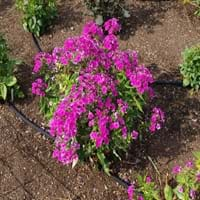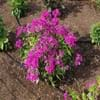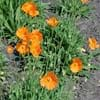Life Span
Perennial
Perennial
Type
Trees
Flowering Plants, Shrubs
Origin
Northeastern United States, Mid-Atlantic United States, Southeastern United States, North-Central United States, Central United States, South-Central United States, Canada
Africa, America, Asia
Types
Blue Ice, Eventide, Starfire
Lockinch, Petite Indigo, White Profusion
Habitat
Dappled Shade, Shady Edge, Woodland Garden
Along Railroads, River side, Roadsides
USDA Hardiness Zone
4-8
5-10
Sunset Zone
1a, 1b, 2a, 2b, 3a, 3b, 4, 5, 6, 7, 8, 9, 10, 11, 12, 13, 14, 18, 19, 20, 21
H1, 2a, 2b, 3a, 3b, 4, 5, 6, 7, 8, 9, 10, 11, 12, 13, 14, 15, 16, 17, 18, 19, 20, 21, 22, 23, 24
Habit
Upright/Erect
Arching/Fountain-shaped
Minimum Height
Not Available
Minimum Width
Not Available
Flower Color
Purple, Magenta
Blue, Pink, Purple, Red, White
Flower Color Modifier
Bicolor
Not Available
Fruit Color
Not Available
Not Available
Leaf Color in Spring
Chartreuse, Gold
Gray Green
Leaf Color in Summer
Chartreuse, Gold
Gray Green, Light Green
Leaf Color in Fall
Chartreuse, Yellow green, Tan
Gray Green, Light Green, Yellow green
Leaf Color in Winter
Not Available
Not Available
Leaf Shape
Ovate
Egg-shaped
Plant Season
Summer, Fall
Fall, Spring, Summer, Winter
Sunlight
Full Sun, Partial Sun
Full Sun, Part sun, Partial shade
Type of Soil
Clay, Loam, Sand
Loamy, Sandy, Well drained
The pH of Soil
Acidic, Neutral, Alkaline
Neutral, Slightly Acidic, Slightly Alkaline
Soil Drainage
Well drained
Well drained
Bloom Time
Summer, Late Summer, Early Fall, Fall
Spring
Tolerances
Not Available
Drought, Pollution, Salt, Soil Compaction
Where to Plant?
Ground
Ground, Pot
How to Plant?
Seedlings
Seedlings, Stem Planting, Transplanting
Plant Maintenance
Medium
Medium
Watering Requirements
Average Water Needs, Doesn't tolerate standing water
Form a Soil ring to water efficiently, Water Deeply, Water twice a day in the initial period
In Summer
Lots of watering
Lots of watering
In Spring
Moderate
Moderate
In Winter
Average Water
Average Water
Soil pH
Acidic, Neutral, Alkaline
Neutral, Slightly Acidic, Slightly Alkaline
Soil Type
Clay, Loam, Sand
Loamy, Sandy, Well drained
Soil Drainage Capacity
Well drained
Well drained
Sun Exposure
Full Sun, Partial Sun
Full Sun, Part sun, Partial shade
Pruning
Remove damaged leaves, Remove dead branches, Remove dead leaves
Cut or pinch the stems, Prune for shortening long shoots, Prune if you want to improve plant shape, Prune ocassionally, Remove damaged leaves, Remove dead or diseased plant parts, Remove deadheads, Remove shoots
Fertilizers
General purpose slow-acting granular fertilizer
All-Purpose Liquid Fertilizer
Pests and Diseases
Powdery mildew, Rust, Septoria leaf spot, Stem canker
Downy mildew, Leaf spot, Spider mites
Plant Tolerance
Drought
Drought
Flower Petal Number
Single
Single
Foliage Texture
Medium
Medium
Foliage Sheen
Matte
Matte
Attracts
Butterflies
Butterflies, Hummingbirds
Aesthetic Uses
Borders, Ground Cover
Showy Purposes
Beauty Benefits
Not Available
Not Available
Environmental Uses
Air purification
Air purification
Medicinal Uses
No Medicinal Use
Not Available
Part of Plant Used
Not Available
Flowers, Leaves
Other Uses
Used as Ornamental plant
Showy Purposes, Used as Ornamental plant
Used As Indoor Plant
No
No
Used As Outdoor Plant
Yes
Yes
Garden Design
Cutflower, Feature Plant, Mixed Border, Wildflower
Edging, Feature Plant, Foundation
Botanical Name
PHLOX paniculata 'Goldmine'
Buddleia davidii
Common Name
Garden Phlox, Goldmine Phlox
Butterfly Bush, Summer Lilac, Butterflybush
In Hindi
Goldmine Phlox
Butterfly Bush
In German
Goldgrube Phlox
Schmetterlingsstrauch
In French
Phlox Goldmine
buisson de papillon
In Spanish
Phlox Goldmine
arbusto de las mariposas
In Greek
Goldmine Phlox
Butterfly Μπους
In Portuguese
Phlox Goldmine
arbusto de borboleta
In Polish
Goldmine Phlox
Butterfly Bush
In Latin
.org Phlox
papilio rubo
Phylum
Magnoliophyta
Spermatophyta
Class
Magnoliopsida
Dicotyledonae
Family
Polemoniaceae
Scrophulariaceae
Clade
Angiosperms, Asterids, Eudicots
Angiosperms, Asterids, Eudicots
Tribe
Phlocideae
Not Available
Subfamily
Polemonioideae
Not Available
Number of Species
Not Available





